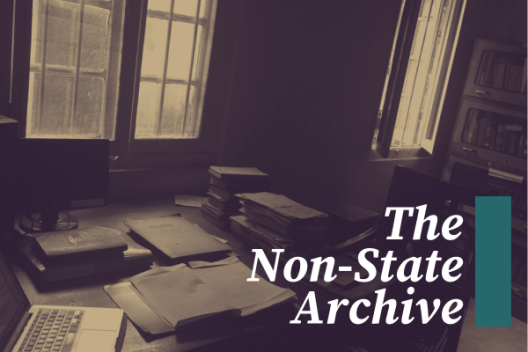
- A digital archive hosted on-site at the Mershon Center for International Security Studies at The Ohio State University.
- Featuring a digital copy of documents, oral histories, and other media related to non-state actors, as well as a finding aid for each collection.
- The archive provides access to researchers and organizations according to the terms of each collection's deposit.
Who is a non-state actor?
Non-State Actors are defined in part by what they are not: official representatives of state governments whose records would generally be housed in state archives. They are nationalist movements and activists, individuals or organizations associated with religious, cultural, political, or other social movements and networks that have not been institutionalized to the extent that they possess their own existing archive. We take a very broad definition of who or what is a non-state actor. It is up to prospective researchers and contributors to make the case for why and how their materials fit within this capacious understanding of the category.
What is the scope of a Non-State Archive collection?
A collection could be the papers of an individual or organization of non-state actors as well as those of a researcher who has worked/is working on a particular community of non-state actors. Organizations and researchers are invited to discuss the possibility of creating a collection with Archive Director Lydia Walker, walker.1380@osu.edu. The Non-State Archive does not accept original materials. Collections are made up of digital copies of documents, images, films, or other media that can be stored on an external hard drive. All materials must be catalogued and digitized according to the practices of the Non-State Archive, and grants—described below—are available to support this. Collections come in all shapes and sizes, though the ideal scope of a collection would be the balance of research materials required for the primary source base of an academic monograph or dissertation.
Grants Scheme:
Researchers can apply for funding to catalogue and digitize their own research materials as well as those of another researcher or those of an interlocutor.
For Ohio State PhD students:
6,000 USD of summer funding to catalog and create a digital copy of (a) their own research material or (b) the research materials of another researcher or interlocutor that they identify in their application. OSU student’s application will include a letter of recommendation from an OSU faculty mentor who may assist them in identifying an external collection. Ohio State PhD students who seek to apply for the grant scheme but cannot identify a relevant collection are encouraged to reach out to Lydia Walker, walker.1380@osu.edu, to be potentially matched with a relevant collection.
For external researchers:
Up to 10,000 USD of funding to copy and catalog their own or their interlocutors’ research materials. Applicants can reside anywhere in the world. They do not need to hold an advanced degree, but they must demonstrate that they have the expertise and access to relevant equipment (and potentially institutional support) to catalog and digitize their collection.
At the end of their fellowship, grant recipients deliver (a) a hard drive containing their collection, (b) a finding aid describing its contents for the benefit of future researchers, and (c) a signed deposit agreement to the Mershon Center. Grant recipients agree to abide by these terms when they take up the fellowship. Copyright remains with the original collection owners who are also provided with a hard drive of their collection in digital form. The physical collection remains in its original location.
Application details:
- CV
- 2-page (single-spaced, Times New Roman, 12pt. font) cover letter that identifies the collection, its scope, the applicant’s experience with it, and the collection’s holder’s interest in having the material copied and cataloged. The cover letter should also articulate the importance of the collection, how it fits under the framework of “non-state actors” and make the case for why the applicant is an appropriate person to archive it–in terms of expertise, experience, and relationship to the collection.
- For external applicants: A budget outlining the funding request and justifying expenses. The Non-State Archive cannot purchase computing or electronic equipment so applicants must demonstrate their access to the equipment they will need to catalog and make a digital copy of their identified collection.
- One letter of recommendation. For OSU PhD students, this letter must come from their chosen faculty mentor.
Submission Instructions:
All application materials should be sent via email attachments to mailto:MRSH-nonstatearchive@osu.edu
Timeline:
- December 6, 2023 – call for applicants
- February 28, 2024 – deadline
- OSU PhD student Non-State Archive grants may be held May-August 2024
- External Non-State Archive grants may be held during the period of July 2024-June 2025.
The Non-State Archive is supported by The Ohio State University’s Provost’s Early Career Scholar’s Program and The Mershon Center for International Security Studies.
